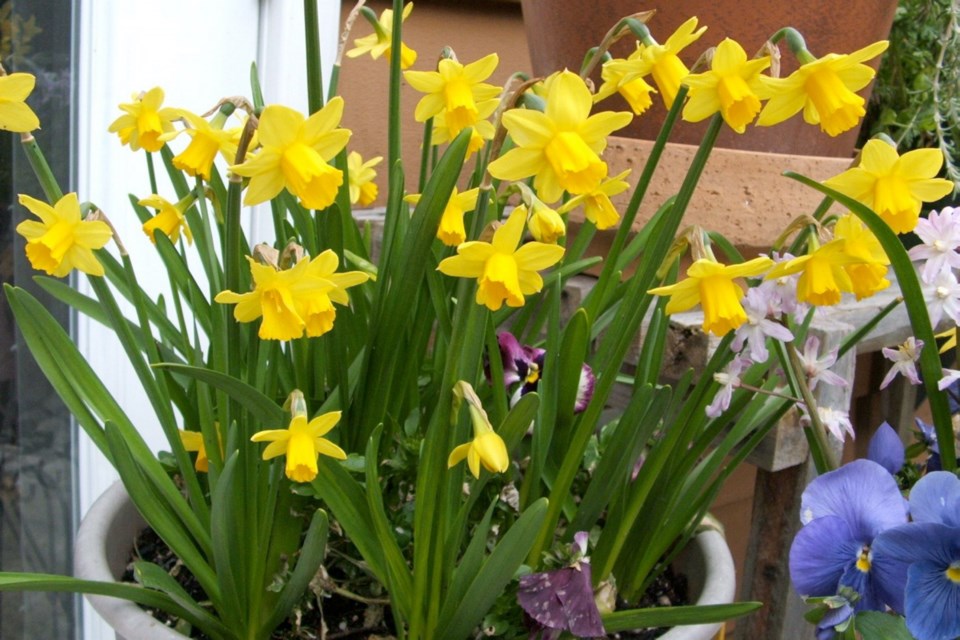Dear Helen: When we returned to live in our lovely Saanich after an absence of 18 years, we were unaware that the deer population around Cedar Hill had expanded greatly — until potted pansies that we placed on the patio were reduced to stalks. Lavender, rosemary and marigolds have been left untouched, but apart from the marigolds there is little colour. I’d appreciate a list of plants that don’t appeal to deer.
G.L.
The first truth to acknowledge is that, if hungry and/or thirsty enough, deer will eat just about anything. Only a fence is sure to bar entry to them. A see-through fence needs to be 240 cm (eight feet) high.
For added summer colour, calendula and dahlia plants are not usually attractive to deer. Dahlias flower over a very long period and are available in a broad range of plant heights and flower colours.
As you have discovered, aromatic herbs like rosemary, lavender and thyme are safe, as are many aromatic plants, such as most other culinary herbs.
More annual flowers that deer are not commonly attracted to are zinnia, salvia, nasturtium, sweet alyssum, cosmos and sunflower.
Among deer-resistant perennials are peony, phlox, sedum, campanula, hardy geranium, and shasta daisy. For shrubs, consider California lilac (Ceanothus), boxwood, rock rose (Cistus), smoke bush, daphne, heathers, skimmia, pieris and choisya (Mexican orange).
Many spring-flowering hardy bulbs are not appealing to deer, daffodils and grape hyacinth among them. In the fall you’ll see them marked as deer resistant on packages in garden centres.
Lists of “deer-proof” plants have been a source of much amusement to readers of this column in the past, and I anticipate the usual spate of chortling comments after this column appears in the paper. Still, consulting such lists at least improves the chances of success in gardens visited by deer.
Dear Helen: I’ve noticed that the issue of improving the texture of heavy clay soils comes up at times in your column. I have the opposite problem. My soil is sandy, super-porous and difficult to keep adequately moist in summer. What’s the solution here?
H.D.
Though it may seem odd, measures to tighten up the loose texture and improve the moisture-holding capacity of sand-based soils are the same as for opening up the texture of clay and improving its ability to drain well of excess moisture. Adding organic matter on a regular basis is the answer.
Why? For the same reason that fibre in the human diet helps to relieve both constipation and diarrhea.
Clay soils have tiny particles that bind tightly together, excluding air and impeding the flow of moisture. Sandy (gritty) soils have large particles that allow liquids (and nutrients) to flow out too rapidly.
Organic materials, such as compost, manures, cover crops (green manures), chopped leaves, grass clippings and organic mulches, improve the aeration and drainage of clay and increase the ability of sandy soils to stay moist and retain nutrients.
Garden events
Orchid show and sale. The Central Vancouver Island Orchid Society is hosting a show and sale on Friday, Saturday and Sunday in the Nanaimo North Town Centre on Rutherford Rd. in Nanaimo. This American Orchid Society judged show will include information on orchid growing, plants for sale, a silent auction, and re-potting by donation. The mall opens on Friday at 9:30, Saturday at 10, Sunday at 11 a.m.
Seedy in Qualicum. Seeding the Future is the theme of the Qualicum Beach Seedy Saturday, 10 a.m. to 3.30 p.m. in the QB Civic Centre, 747 Jones St. The event will feature more than 70 vendors, a swap of garden-saved seeds, master gardeners, Seedy Café, Milner Garden’s Shoots with Roots children’s program, and a truck for collecting pesticides and herbicides. Speakers are Carolyn Herriot (10:30 a.m.) on Eco-Nutrition and Larry Church (12:30 p.m.) on mason bees. Admission is by donation.
Foraging for food. The Horticulture Centre of the Pacific, 505 Quayle Rd. in Saanich, is offering a workshop on Foraging Winter Food Plants on Saturday, 1 to 3 p.m. Learn how to identify and prepare native and introduced species that are edible during the winter, with a focus on the health benefits of eating wild food and on sustainable harvesting practices. The class will include a food preparation demonstration. Cost to HCP members $30, others $35. To register, call 250-479-6162.



